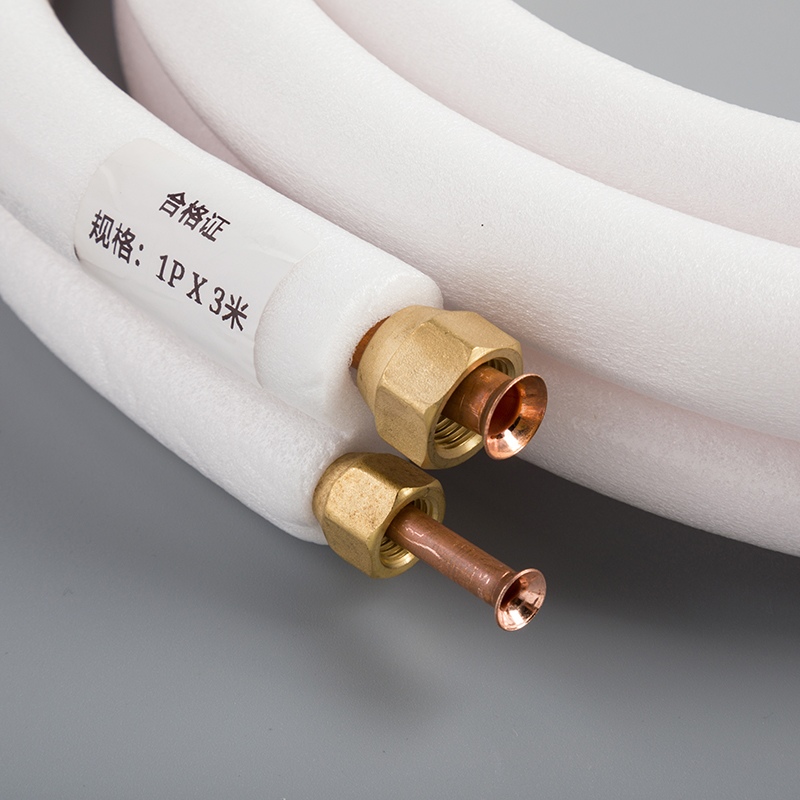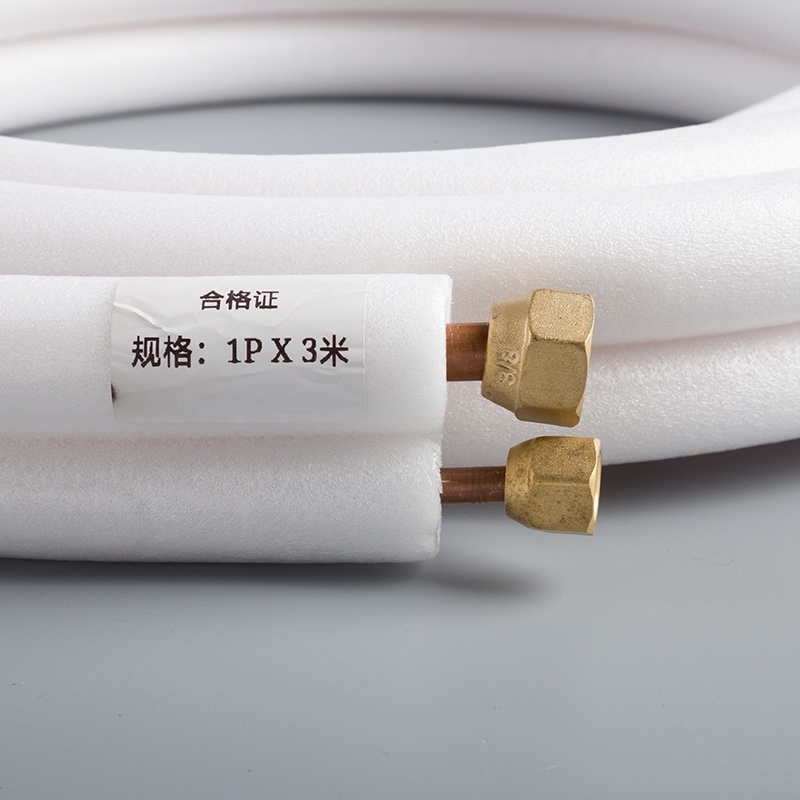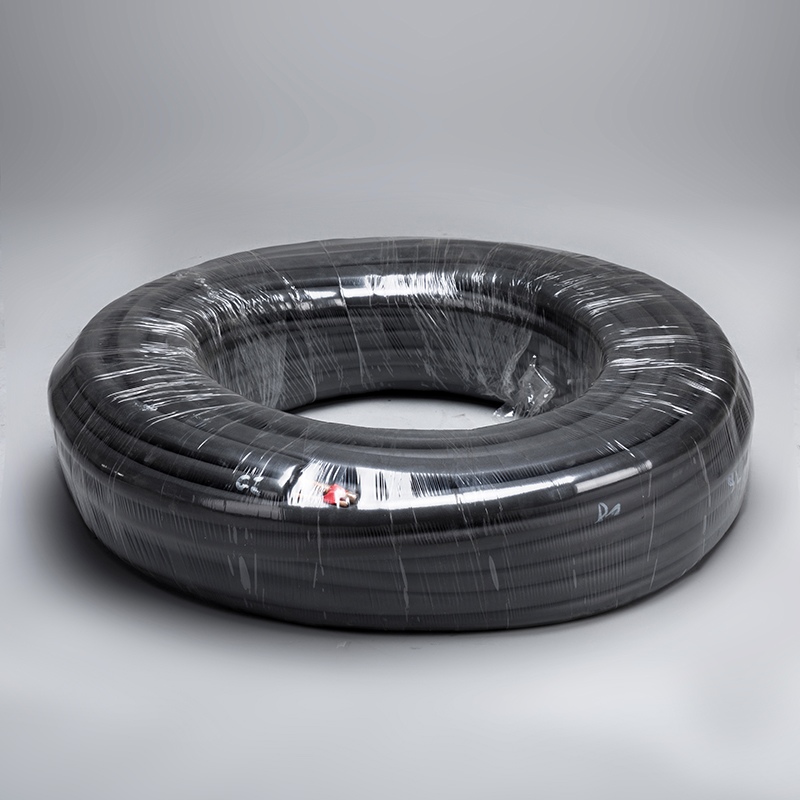Copper Pipes vs Aluminum Pipes for Air Conditioning

When it comes to air conditioning systems, selecting the right pipe material is crucial for ensuring both efficiency and durability. In this comparison blog post on 'Copper Pipes vs Alternative Materials for Air Conditioning,' we delve into the key differences between copper pipes and their alternatives, such as aluminum pipes. Copper pipes stand out for their exceptional thermal conductivity, making them an ideal choice for energy-efficient cooling and reliable performance. On the other hand, aluminum pipes are favored for their cost-effectiveness and flexibility, catering to those seeking budget-friendly solutions. By exploring the advantages and drawbacks of these materials, this comparison provides valuable insights to help you make informed decisions for your HVAC needs.
Applications of Copper Pipes

Common Uses in Air Conditioning
Residential Systems
Copper pipes play a vital role in residential air conditioning systems. The exceptional thermal conductivity of copper ensures efficient heat transfer, which enhances cooling performance. Copper pipes are commonly used in refrigerant lines to circulate refrigerants effectively. The durability of copper provides resistance to mechanical damage, ensuring long-lasting performance in home HVAC systems. The corrosion-resistant properties of copper contribute to healthier indoor air quality by minimizing the risk of contaminants entering the system.
Commercial Systems
Commercial air conditioning systems rely heavily on copper pipes for their strength and reliability. Copper pipes handle the high pressure and temperature variations often present in large-scale HVAC systems. The superior thermal conductivity of copper supports efficient cooling in commercial spaces, reducing energy consumption. Copper pipes also withstand external damages, making them suitable for demanding environments such as office buildings, shopping malls, and industrial facilities. The versatility of copper allows its use in various applications, including chilled water systems and refrigerant transportation.
Installation Process
Tools and Materials Needed
The installation of copper pipes requires specific tools and materials to ensure proper assembly. The following items are essential:
Pipe cutter for precise cutting of copper pipes.
Tube bender to shape pipes without causing damage.
Flaring tool for creating flared ends for secure connections.
Brazing torch and solder for joining pipe sections.
Pipe insulation to prevent heat loss and condensation.
Measuring tape and marker for accurate measurements.
The use of high-quality tools and materials ensures a reliable and efficient installation process.
Step-by-Step Guide
Measure the required length of copper pipe using a measuring tape.
Cut the pipe to the desired length using a pipe cutter.
Use a tube bender to shape the pipe according to the layout of the air conditioning system.
Clean the pipe ends and fittings to remove debris or oxidation.
Apply a flaring tool to create flared ends for secure connections.
Join the pipe sections using a brazing torch and solder to create leak-proof joints.
Insulate the pipes with pipe insulation to enhance energy efficiency.
Test the system for leaks and ensure proper functionality.
The step-by-step process ensures a seamless installation of copper pipes in air conditioning systems.
Applications of Aluminum Pipes

Common Uses in Air Conditioning
Residential Systems
Aluminum pipes serve as a practical choice for residential air conditioning systems. The lightweight nature of aluminum simplifies installation in compact spaces. Aluminum pipes provide sufficient thermal conductivity, which ensures effective heat transfer for cooling purposes. The flexibility of aluminum allows easier adjustments during installation, reducing labor efforts. Many homeowners prefer aluminum pipes due to their lower initial cost compared to copper alternatives.
Commercial Systems
Commercial air conditioning systems often utilize aluminum pipes for cost-efficient operations. The reduced weight of aluminum minimizes structural stress in large-scale HVAC installations. Aluminum pipes offer adequate performance in transporting refrigerants across extensive networks. The affordability of aluminum makes it suitable for commercial projects with budget constraints. Aluminum materials resist corrosion under specific conditions, which extends the lifespan of the piping system in controlled environments.
Installation Process
Tools and Materials Needed
The installation of aluminum pipes requires specific tools and materials for optimal results. Below is a list of essential items:
Pipe cutter designed for aluminum materials.
Tube bender to shape aluminum pipes without causing cracks.
Compression fittings for secure and leak-proof connections.
Sealant or adhesive suitable for aluminum joints.
Measuring tape for precise length calculations.
Pipe insulation to maintain energy efficiency.
The use of appropriate tools ensures a smooth and efficient installation process.
Step-by-Step Guide
Measure the required length of aluminum pipe using a measuring tape.
Cut the pipe to the desired size with an aluminum-specific pipe cutter.
Use a tube bender to create the necessary shapes for the system layout.
Clean the pipe ends to remove debris and ensure proper sealing.
Attach compression fittings to connect pipe sections securely.
Apply sealant or adhesive to reinforce the joints and prevent leaks.
Insulate the pipes with suitable materials to reduce energy loss.
Test the system for any leaks and confirm proper functionality.
The step-by-step process ensures reliable performance and durability of aluminum pipes in air conditioning systems.
Advantages of Copper Pipes
Durability
Longevity
Copper pipes exhibit exceptional longevity due to their mechanical strength and resistance to wear. Studies reveal that copper pipes often last between 70 to 80 years, with proper maintenance extending their lifespan even further. The robust structure of copper ensures minimal degradation over time, making it a reliable choice for air conditioning systems. Innovations in material science and manufacturing techniques have further enhanced the durability of copper pipes, ensuring consistent performance across decades.
The extended service life of copper pipes reduces the need for frequent replacements. This long-term reliability makes copper an economical choice despite higher initial costs. Compared to alternative materials, copper pipes consistently outperform in terms of longevity, providing significant value for residential and commercial HVAC applications.
Resistance to Corrosion
Copper pipes possess natural corrosion-resistant properties, which contribute to their widespread use in air conditioning systems. Unlike steel or other metals, copper resists the effects of water and environmental factors that typically cause corrosion. This resistance ensures uninterrupted operation and prevents leaks or system failures over time. Research highlights that copper's ability to withstand repeated exposure to water enhances its reliability in HVAC systems.
The corrosion resistance of copper pipes also supports healthier indoor air quality by minimizing contamination risks. This property makes copper an ideal material for transporting refrigerants and other fluids in air conditioning systems. The durability provided by corrosion resistance ensures that copper pipes maintain structural integrity even under demanding conditions.
Thermal Conductivity
Efficiency in Heat Transfer
Copper pipes are renowned for their superior thermal conductivity, which directly impacts heat transfer efficiency. With a thermal conductivity of 385 W/mK, copper ranks among the most effective materials for transferring heat in air conditioning systems. This high conductivity enables rapid cooling and heating processes, optimizing system performance. The efficient heat transfer provided by copper reduces energy consumption, contributing to cost savings for users.
The ability of copper to handle large temperature variations without compromising performance further enhances its suitability for HVAC applications. This characteristic ensures consistent cooling in both residential and commercial environments. The exceptional thermal conductivity of copper pipes sets them apart from alternative materials, making them a preferred choice for energy-efficient systems.
Energy Savings
The energy-saving potential of copper pipes stems from their excellent thermal conductivity and durability. Efficient heat transfer minimizes energy loss during operation, reducing overall power consumption. This efficiency translates into lower utility bills for users, making copper pipes a cost-effective option over time. The reduced energy demand also aligns with sustainability goals, as it lowers the carbon footprint of air conditioning systems.
Copper pipes maintain consistent performance throughout their lifespan, ensuring long-term energy efficiency. The combination of durability and thermal conductivity positions copper as a superior material for HVAC systems. When comparing copper pipes to alternative materials, the energy-saving benefits become a key factor in decision-making.
Advantages of Aluminum Pipes
Cost-Effectiveness
Initial Cost
Aluminum pipes offer a significant advantage in terms of affordability. The material cost of aluminum is lower compared to copper, making aluminum pipes a preferred choice for budget-conscious air conditioning projects. Large-scale installations benefit from the reduced expense, as aluminum allows for cost savings without sacrificing functionality. Many distributors and service providers recommend aluminum pipes for projects requiring economic solutions.
The lightweight nature of aluminum reduces transportation costs. Manufacturers often highlight this feature as a key factor in minimizing overall project expenses. The affordability of aluminum pipes makes them accessible for both residential and commercial applications, ensuring widespread use in the HVAC industry.
Maintenance Costs
Maintenance costs for aluminum pipes remain relatively low. The corrosion resistance of aluminum under controlled conditions reduces the frequency of repairs. Properly installed aluminum pipes demonstrate durability, which minimizes the need for replacements. Service providers often emphasize the long-term savings associated with aluminum piping systems.
The flexibility of aluminum simplifies maintenance procedures. Technicians find aluminum pipes easier to handle during inspections and repairs, further reducing labor costs. Many air conditioning systems rely on aluminum pipes for their cost-effectiveness in both initial investment and ongoing maintenance.
Weight
Ease of Handling
The lightweight nature of aluminum pipes enhances ease of handling during installation. Aluminum weighs significantly less than copper, which simplifies transportation and storage. Installers find aluminum pipes more manageable, especially in projects involving complex layouts or confined spaces. The reduced weight also lowers the risk of physical strain for workers.
Many professionals in the HVAC industry prefer aluminum pipes for their practicality. The lightweight design enables faster assembly, which improves overall efficiency. Aluminum's ease of handling contributes to its popularity in residential and commercial air conditioning systems.
Impact on Installation Time
The reduced weight of aluminum pipes directly impacts installation time. Workers complete projects more quickly due to the simplified handling process. Aluminum pipes require fewer resources for lifting and positioning, which accelerates the assembly of air conditioning systems. Many contractors recommend aluminum for projects with tight deadlines.
The flexibility of aluminum further shortens installation time. Installers can bend and adjust aluminum pipes with minimal effort, allowing for seamless integration into HVAC systems. The combination of lightweight properties and adaptability makes aluminum a time-efficient choice for air conditioning installations.
Disadvantages of Copper Pipes
Cost
Initial Investment
Copper pipes require a higher initial investment compared to alternative materials. The production process of copper involves extensive mining and refining, which increases costs. The price of copper fluctuates in the global market, often making it two to three times more expensive than aluminum or plastic pipes. L-type copper pipes, known for their thicker walls and durability, further add to the cost. Many air conditioning projects face budget constraints due to the high upfront expense of copper piping systems.
The long-term benefits of copper pipes, such as durability and efficiency, justify the cost for some users. However, the steep initial investment often deters those seeking affordable solutions. Alternative materials like aluminum provide a more economical option for projects with limited budgets.
Repair Costs
Repairing copper pipes can be costly due to the specialized tools and skills required. Damaged copper pipes often need brazing or soldering, which demands professional expertise. The cost of hiring skilled technicians adds to the overall expense of maintenance. Replacement parts for copper pipes are also more expensive than those for alternative materials.
Corrosion or leaks in copper pipes, while rare, can lead to significant repair expenses. The longevity of copper pipes reduces the frequency of repairs, but the associated costs remain high when issues arise. Many service providers recommend regular inspections to minimize potential repair expenses.
Weight
Handling Challenges
The weight of copper pipes poses challenges during transportation and installation. Copper is heavier than aluminum, which increases shipping costs for large-scale projects. Workers often face difficulties in handling and positioning heavy copper pipes, especially in confined spaces. The physical strain associated with lifting copper pipes can slow down the installation process.
The use of heavy-duty equipment becomes necessary for managing copper pipes in commercial installations. This requirement adds complexity and cost to the project. Many contractors prefer lightweight materials like aluminum to avoid handling challenges.
Impact on Installation Time
The weight of copper pipes directly impacts installation time. Heavier pipes require more effort and resources to position and secure. The need for additional support structures prolongs the assembly process. Installers often spend more time aligning and connecting copper pipes compared to lighter alternatives.
The rigidity of copper pipes further complicates adjustments during installation. Flexible materials like aluminum allow for quicker modifications, reducing labor hours. The extended installation time associated with copper pipes increases project timelines and labor costs.
Disadvantages of Aluminum Pipes
Durability
Susceptibility to Corrosion
Aluminum pipes face challenges in environments with high humidity or exposure to saltwater. Moisture and certain chemicals can cause aluminum to corrode over time. Corrosion weakens the structural integrity of aluminum pipes, leading to potential leaks or failures in air conditioning systems. Protective coatings or controlled environments reduce corrosion risks, but these measures increase maintenance requirements.
Scientific studies highlight that aluminum tubing resists formicary corrosion better than copper. However, aluminum remains vulnerable to other forms of corrosion, especially in harsh conditions. The susceptibility to corrosion limits the use of aluminum pipes in specific applications where durability is critical.
Longevity Concerns
The lifespan of aluminum pipes is shorter compared to copper alternatives. Frequent exposure to temperature fluctuations and external pressures accelerates wear and tear. Over time, aluminum pipes may require replacements more often, increasing long-term costs for air conditioning systems.
The lightweight nature of aluminum contributes to its reduced durability. High-pressure systems or heavy mechanical stress can deform aluminum pipes. The limited longevity of aluminum pipes makes them less suitable for installations requiring extended service life.
Thermal Conductivity
Efficiency in Heat Transfer
Aluminum pipes exhibit lower thermal conductivity compared to copper. The thermal conductivity of aluminum measures 205 W/mK, which is significantly lower than copper’s 385 W/mK. This difference impacts the efficiency of heat transfer in air conditioning systems. Reduced heat transfer efficiency leads to slower cooling or heating processes.
The lower thermal conductivity of aluminum pipes increases energy consumption during operation. Systems using aluminum pipes may require additional energy to achieve desired temperature levels, reducing overall performance. The efficiency gap between aluminum and copper pipes becomes evident in high-demand HVAC applications.
Energy Consumption
Air conditioning systems with aluminum pipes consume more energy due to reduced thermal efficiency. The increased energy demand results in higher utility bills for users. Aluminum pipes contribute to greater environmental impact through elevated carbon emissions from energy usage.
The energy-saving potential of copper pipes surpasses that of aluminum in HVAC systems. Aluminum pipes require more insulation to minimize energy loss, adding to installation complexity. The higher energy consumption associated with aluminum pipes affects their cost-effectiveness in the long term.
Practical Recommendations
Combining Copper and Aluminum Pipes
Optimal Scenarios
Combining copper and aluminum pipes can optimize HVAC system performance. Copper pipes excel in areas requiring high thermal conductivity and durability. Aluminum pipes perform well in applications where cost reduction and lightweight materials are priorities. Residential systems with limited budgets benefit from aluminum pipes in non-critical sections, while copper pipes ensure efficient refrigerant flow in critical areas. Commercial installations with extensive networks can use aluminum pipes for low-pressure zones and copper pipes for high-pressure zones.
Copper pipes play a critical role in refrigerant lines due to their ability to facilitate efficient heat transfer. Aluminum pipes reduce structural stress in large-scale HVAC systems because of their lightweight nature. Combining both materials allows engineers to balance cost-effectiveness with system efficiency. This approach extends the lifespan of HVAC systems by leveraging the strengths of each material.
Cost-Benefit Analysis
A cost-benefit analysis highlights the financial advantages of combining copper and aluminum pipes. Copper pipes require higher initial investment but provide long-term savings through durability and energy efficiency. Aluminum pipes reduce upfront costs, making them suitable for projects with tight budgets. Combining these materials minimizes overall expenses while maintaining system reliability.
Copper pipes reduce energy consumption due to superior thermal conductivity, leading to lower utility bills. Aluminum pipes simplify installation, reducing labor costs. The combination of these materials creates a balanced solution for HVAC systems. Engineers and contractors achieve optimal results by utilizing copper and aluminum pipes strategically.
Real-World Examples
Case Study 1
A residential air conditioning project in a coastal region utilized a combination of copper and aluminum pipes. Copper pipes were installed in refrigerant lines to handle high thermal demands and resist corrosion. Aluminum pipes were used in secondary lines to reduce costs and simplify installation. The system achieved efficient cooling performance and minimized maintenance requirements.
The project demonstrated the benefits of material selection based on application needs. Copper pipes ensured reliable refrigerant flow, while aluminum pipes reduced structural stress. The combination extended the system's lifespan and provided a cost-effective solution for the homeowner.
Case Study 2
A commercial HVAC system in a shopping mall integrated copper and aluminum pipes for optimal performance. Copper pipes were chosen for high-pressure zones to withstand temperature variations and mechanical stress. Aluminum pipes were installed in low-pressure zones to reduce material and transportation costs. The system delivered consistent cooling across the large facility.
The shopping mall experienced significant energy savings due to the thermal efficiency of copper pipes. Aluminum pipes simplified the installation process, reducing project timelines. The balanced approach highlighted the practical advantages of combining copper and aluminum pipes in large-scale applications.
Copper pipes and aluminum pipes each offer unique benefits for air conditioning systems. Copper pipes provide superior thermal conductivity, durability, and recyclability, making them a long-lasting and sustainable choice. Aluminum pipes deliver cost-effectiveness, lightweight handling, and flexibility, which suit budget-conscious projects. Combining both materials enhances system efficiency while reducing costs. Copper pipes excel in critical areas requiring high performance, while aluminum pipes perform well in less demanding sections. A balanced approach ensures optimal results for residential and commercial HVAC applications.
See Also
The Benefits Of Copper Pipes In Air Conditioning Systems
Pure Copper Pipes: Essential For Optimal Air Conditioning Efficiency
Transforming Air Conditioning With The Power Of Copper Pipes
Comparing Copper And Aluminum Tubes For Air Conditioning Efficiency
Key Advantages Of Copper Pipes In Air Conditioning Solutions


